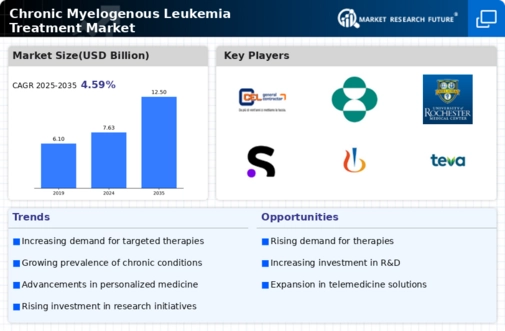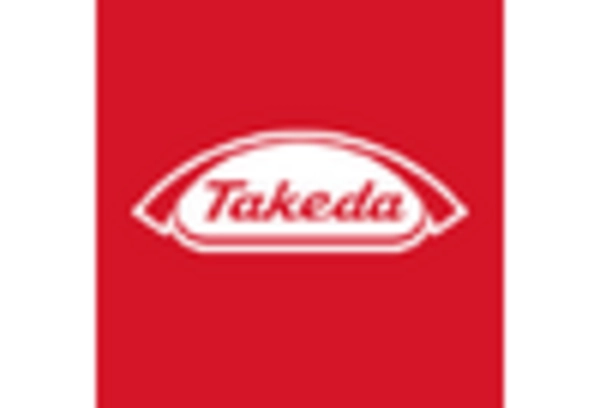Increase in Incidence Rates
The rising incidence rates of Chronic Myelogenous Leukemia (CML) are a primary driver for the Chronic Myelogenous Leukemia Treatment Market. Recent statistics indicate that the prevalence of CML has been steadily increasing, with an estimated 1.5 cases per 100,000 individuals annually. This trend necessitates the development and availability of effective treatment options, thereby propelling market growth. As more individuals are diagnosed, healthcare systems are compelled to allocate resources towards innovative therapies and management strategies. The increasing patient population not only drives demand for existing treatments but also stimulates research and development efforts aimed at discovering novel therapeutic agents. Consequently, the Chronic Myelogenous Leukemia Treatment Market is likely to experience significant expansion as stakeholders respond to the growing need for effective management solutions.
Advancements in Drug Development
Technological advancements in drug development are significantly influencing the Chronic Myelogenous Leukemia Treatment Market. The emergence of novel therapeutic agents, particularly tyrosine kinase inhibitors (TKIs), has revolutionized treatment protocols for CML. Recent developments have led to the introduction of second and third-generation TKIs, which offer improved efficacy and reduced side effects compared to earlier treatments. For instance, drugs like ponatinib and bosutinib have shown promising results in clinical trials, enhancing patient outcomes. Furthermore, the integration of artificial intelligence and machine learning in drug discovery processes is expediting the identification of potential CML therapies. This innovation not only accelerates the time-to-market for new drugs but also enhances the overall treatment landscape, thereby driving growth within the Chronic Myelogenous Leukemia Treatment Market.
Rising Investment in Oncology Research
The surge in investment directed towards oncology research is a notable driver for the Chronic Myelogenous Leukemia Treatment Market. Increased funding from both public and private sectors has facilitated extensive research into the pathophysiology of CML and the development of targeted therapies. This financial support has led to breakthroughs in understanding the molecular mechanisms underlying CML, paving the way for innovative treatment strategies. Furthermore, collaborations between academic institutions and pharmaceutical companies are becoming more prevalent, enhancing the research landscape. As investment in oncology continues to rise, it is anticipated that the Chronic Myelogenous Leukemia Treatment Market will benefit from a steady influx of new therapies and improved treatment protocols.
Growing Awareness and Screening Programs
The increasing awareness surrounding Chronic Myelogenous Leukemia and the implementation of screening programs are pivotal factors driving the Chronic Myelogenous Leukemia Treatment Market. Educational initiatives aimed at both healthcare professionals and the general public have led to earlier diagnosis and treatment of CML. As awareness grows, more individuals are encouraged to undergo routine screenings, which can lead to timely interventions. This proactive approach not only improves patient outcomes but also contributes to a larger patient pool seeking treatment. Consequently, healthcare providers are more likely to invest in CML therapies, further stimulating market growth. The emphasis on early detection and management is expected to continue shaping the Chronic Myelogenous Leukemia Treatment Market in the coming years.
Regulatory Support for Innovative Therapies
Regulatory bodies are increasingly supporting the development of innovative therapies for Chronic Myelogenous Leukemia, which is a crucial driver for the Chronic Myelogenous Leukemia Treatment Market. Initiatives such as expedited review processes and orphan drug designations for CML treatments have encouraged pharmaceutical companies to invest in research and development. This regulatory environment fosters innovation, allowing for the rapid introduction of new therapies that can address unmet medical needs. Additionally, the approval of combination therapies and novel treatment regimens is likely to enhance patient outcomes and expand treatment options. As regulatory frameworks continue to evolve, they are expected to play a significant role in shaping the future landscape of the Chronic Myelogenous Leukemia Treatment Market.


















Leave a Comment